Characteristics of Orographic Rain Drop-Size Distribution at Cherrapunji, Northeast India
Abstract
1. Introduction
2. Data and Analysis Methods
3. Results
3.1. Comparison with Raingauge
3.2. Features of the DSD
3.3. Seasonal Variation Based on PCA
3.4. Contribution of LNSD
4. Summary and Discussion
Author Contributions
Funding
Acknowledgments
Conflicts of Interest
Abbreviations
| DSD | drop size distribution |
| EOF | empirical orthogonal function |
| LNSD | large number of small drops |
| SND | small number of drops |
| PCA | principal component analysis |
| Parsivel | PArticle SIze and VELocity |
References
- Roe, G.H. Orographic precipitation. Annu. Rev. Earth Planet. Sci. 2005, 33, 645–671. [Google Scholar] [CrossRef]
- Xie, S.P.; Xu, H.; Saji, N.H.; Wang, Y. Role of narrow mountains in large-scale organization of Asian monsoon convection. J. Clim. 2006, 19, 3420–3429. [Google Scholar] [CrossRef]
- Rosenfeld, D.; Ulbrich, C.W. Cloud microphysical properties, processes, and rainfall estimation opportunities. in “Radar and Atmospheric Science: A Collection of Essays in Honor of David Atlas”. Meteor. Monogr. 2003, 52, 237–258. [Google Scholar] [CrossRef]
- Jaffrain, J.; Berne, A. Experimental quantification of the sampling uncertainty associated with measurements from PARSIVEL disdrometers. J. Hydrometeor. 2011, 12, 352–370. [Google Scholar] [CrossRef]
- Friedrich, K.; Higgins, S.; Masters, F.J.; Lopez, C.R. Articulating and stationary PARSIVEL disdrometer measurements in conditions with strong Winds and heavy rainfall. J. Atmos. Oceanic Technol. 2013, 30, 2063–2080. [Google Scholar] [CrossRef]
- Zwiebel, J.; Ban Baelen, J.; Anquetin, S.; Pointin, Y.; Boudevillain, B. Impacts of orography and rain intensity on rainfall struction. The case of the HyMeX IOP7a event. Quart. J. Roy. Meteor. Soc. 2016, 142 (Suppl. 1), 310–319. [Google Scholar] [CrossRef]
- Marshall, J.S.; Palmer, W.M. The distribution of raindrops with size. J. Meteor. 1948, 5, 165–166. [Google Scholar] [CrossRef]
- Steiner, M.; Smith, J.A.; Uijlenhoet, R. A microphysical interpretation of radar reflectivity-rain rate relationships. J. Atmos. Sci. 2004, 61, 1114–1131. [Google Scholar] [CrossRef]
- Harikumar, R. Orographic effect on tropical rain physics in the Asian monsoon region. Atmos. Sci. Lett. 2016, 17, 556–563. [Google Scholar] [CrossRef]
- Dolan, B.; Fuchs, B.; Rutledge, S.A.; Barnes, E.A.; Thompson, E.J. Primary modes of global drop-size distributions. J. Atmos. Sci. 2018, 75, 1453–1476. [Google Scholar] [CrossRef]
- Liu, C.; Zipser, E.J. Why does radar reflectivity tend to increase downward toward the ocean surface, but decrease downward toward the land surface? J. Geophys. Res. 2013, 118, 135–148. [Google Scholar] [CrossRef]
- Barros, A.P.; Arulraj, M. Remote sensing of orographic precipitation. In Satellite Precipitation Measurement; Springer: Cham, Switzerland, 2020; Volume 69. [Google Scholar] [CrossRef]
- Rao, T.N.; Rao, D.N.; Mohan, K. Classification of tropical precipitating systems and associated Z-R relationships. J. Geophys. Res. 2001, 106, 17,699–17,711. [Google Scholar] [CrossRef]
- Reddy, K.K.; Kozu, T. Measurements of raindrop size distribution over Gadanki during south-west and north-east monsoon. Indian J. Radio Space Phys. 2003, 32, 286–295. [Google Scholar]
- Sen Roy, S.; Datta, R.K.; Bhatia, R.C.; Sharma, A.K. Drop size distributions of tropical rain over south India. Geofizika 2005, 22, 105–130. [Google Scholar]
- Harikumar, R.; Kumar, V.S.; Sampath, S.; Vinayak, P.V.S.S.K. Comparison of drop size distribution between stations in eastern and western coasts of India. J. Ind. Geophys. Union 2007, 11, 111–116. [Google Scholar]
- Kirankumar, N.V.P.; Rao, T.N.; Radhakrishna, B.; Rao, D.N. Statistical characteristics of raindrop size distribution in southwest monsoon season. J. Appl. Meteor. Climatol. 2007, 47, 576–590. [Google Scholar] [CrossRef]
- Rao, T.N.; Radhakrishna, B.; Nakamura, K.; Rao, N.P. Differences in raindrop size distribution from southwest monsoon to northeast monsoon at Gadanki. Quart. J. Roy. Meteor. Soc. 2009, 135, 1630–1637. [Google Scholar]
- Sharma, S.; Konwar, M.; Sarma, D.K.; Kalapureddy, M.C.R.; Jain, A.R. Characteristics of rain integral parameters during tropical convective, transition, and stratiform rain at Gadanki and its application in rain retrieval. J. Appl. Meteor. Climatol. 2009, 48, 1245–1266. [Google Scholar] [CrossRef]
- Kumar, S.B.; Reddy, K.K. Rain drop size distribution characteristics of cyclonic and north east monsoon thunderstorm precipitating clouds observed over Kadapa (14.47° N, 78.82° E), tropical semi-arid region of India. Mausam 2013, 64, 35–48. [Google Scholar]
- Sulochana, Y.; Rao, T.N.; Sunilkumar, K.; Chandrika, P.; Raman, M.R.; Rao, S.V.B. On the seasonal variability of raindrop size distribution and associated variations in reflectivity - rainrate relations at Trupati, a tropical station. J. Atmos. Solar-Terrestorial Phys. 2016, 147, 98–105. [Google Scholar] [CrossRef]
- Konwar, M.; Das, S.K.; Deshpande, S.M.; Chakravarty, K.; Goswami, B.N. Microphysics of clouds and rain over the Western Ghat. J. Geophys. Res. 2014, 119, 6140–6159. [Google Scholar] [CrossRef]
- Deshpande, S.M.; Dhangar, N.; Das, S.K.; Kalapureddy, M.C.R.; Chakravarty, K.; Sonbawne, S.; Konwar, M. Mesoscale kinematics derived from X-band Doppler radar observations of convective versus stratiform precipitation and comparison with GPS radiosonde profiles. J. Geophys. Res. 2015, 120, 11536–11551. [Google Scholar] [CrossRef]
- Utsav, B.; Deshpande, S.M.; Das, S.K.; Pandithurai, G. Statistical characteristcis of convective clouds over the Western Ghats derived from westhern radar observations. J. Geophys. Res. 2017, 122, 10050–10076. [Google Scholar] [CrossRef]
- Utsav, B.; Deshpande, S.M.; Das, S.K.; Pandithurai, G.; Niyogi, D. Observed vertical structure of convection during dry and wet summer monsoon epochs over the Western Ghats. J. Geophys. Res. 2019, 124, 1352–1369. [Google Scholar] [CrossRef]
- Chakravarty, K.; Raj, P.; Bhattacharya, A.; Maitra, A. Microphysical characteristics of clouds and precipitation during pre-monsoon and monsoon period over a tropical Indian station. J. Atmos. Solar-Terrestorial Phys. 2013, 94, 28–33. [Google Scholar] [CrossRef]
- Stiller-Reeve, M.A.; Syed, M.A.; Spengler, T.; Spinney, J.A.; Hossain, R. Complementing scientific monsoon definitions with social perception in Bangladesh. Bull. Amer. Meteor. Soc. 2015, 96, 49–57. [Google Scholar] [CrossRef]
- Zipser, E.J.; Cecil, D.J.; Liu, C.; Nesbitt, S.W.; Yorty, D.P. Where are the most intense thunderstorms on earth? Bull. Amer. Meteor. Soc. 2006, 96, 1057–1071. [Google Scholar] [CrossRef]
- Das, S.; Mohanty, U.C.; Tyagi, A.; Sikka, D.R.; Joseph, P.V.; Rathore, L.S.; Habib, A.; Baidya, S.K.; Sonam, K.; Sarkar, A. The SAARC STORM: A coordinated field experiment on severe thunderstorm observations and regional modeling over the South Asian region. Bull. Amer. Meteor. Soc. 2014, 95, 603–617. [Google Scholar] [CrossRef]
- Choudhury, B.A.; Konwar, M.; Hazra, A.; Mohan, G.M.; Pithani, P.; Ghude, S.D.; Deshamukhya, A. A diagnostic study of cloud physics and lightning flash rates in a severe pre-monsoon thunderstorm over northeast India. Quart. J. Roy. Meteor. Soc. 2020, 1–22. [Google Scholar] [CrossRef]
- Loffler-Mang, M.; Joss, J. An optical disdrometer for measuring size and velocity of hydrometers. J. Atmos. Oceanic Technol. 2000, 17, 130–139. [Google Scholar] [CrossRef]
- Loffler-Mang, M.; Blahak, U. Estimation of the equivalent radar reflectivity factor from measured snow size spectra. J. Appl. Meteor. 2001, 40, 843–849. [Google Scholar] [CrossRef]
- Battaglia, A.; Rustemier, E.; Tokay, A.; Blahak, U.; Simmer, C. PARSIVEL snow observations: A critical assessment. J. Atmos. Oceanic Technol. 2010, 27, 333–344. [Google Scholar] [CrossRef]
- Tokay, A.; Petersen, W.A.; Gatlin, P.; Wingo, M. Comparison of raindrop size distribution measurements by collocated disdrometers. J. Atmos. Oceanic Technol. 2013, 30, 1672–1690. [Google Scholar] [CrossRef]
- Tokay, A.; Wolff, D.B.; Petersen, W.A. Evaluation of the new version of the laser-optical disdrometer, OTT Parsivel2. J. Atmos. Oceanic Technol. 2014, 31, 1276–1288. [Google Scholar] [CrossRef]
- Angulo-Martinez, M.; Begueria, S.; Latorre, B.; Fernandez-Raga, M. Comparison of precipitation measurements by OTT Parsivel2 and Thies LPM optical disdrometers. Hydrol. Earth Syst. Sci 2018, 22, 2811–2837. [Google Scholar] [CrossRef]
- Kalina, E.A.; Friedrich, K.; Ellis, S.M.; Burgess, D.W. Comparison of disdrometer and X-band mobile radar observations in convective precipitation. Mon. Wea. Rev. 2014, 142, 2414–2435. [Google Scholar] [CrossRef]
- Gunn, R.; Kinzer, G.D. The terminal velocity of fall for water droplets in stagnant air. J. Meteor. 1949, 6, 243–248. [Google Scholar] [CrossRef]
- Atlas, D.; Srivastava, R.C.; Sekhon, R.S. Doppler radar characteristics of precipitation at vertical incidence. Rev. Geophys. 1973, 11, 1–35. [Google Scholar] [CrossRef]
- Smith, P.L.; Liu, Z.; Joss, J. A study of sampling-variability effects in raindrop size observations. J. Appl. Meteor. 1993, 32, 1259–1269. [Google Scholar] [CrossRef]
- Smith, P.L. Sampling issues in estimating radar variables from disdrometer data. J. Atmos. Oceanic Technol. 2016, 33, 2305–2313. [Google Scholar] [CrossRef]
- Willis, P.T. Functional fits to some observed drop size distributions and parameterization of rain. J. Atmos. Sci. 1984, 41, 1648–1661. [Google Scholar] [CrossRef]
- Testud, J.; Oury, S.; Black, R.A.; Amayenc, P.; Dou, X. The concept of “normalized” distribution to describe raindrop spectra: A tool for cloud physics and cloud remote sensing. J. Appl. Meteor. 2001, 40, 1118–1140. [Google Scholar] [CrossRef]
- Bringi, V.N.; Huang, G.J.; Chandrasekar, V. A methodology for the parameters of a gamma raindrop size distribution model from polarimetric radar data: Application to a squall-line event from the TRMM/Brazil campaign. J. Atmos. Oceanic Technol. 2002, 19, 633–645. [Google Scholar] [CrossRef]
- Ulbrich, C.W. Natural variations in the analytical form of the raindrop size distribution. J. Appl. Meteor. 1983, 22, 1764–1775. [Google Scholar] [CrossRef]
- Cao, Q.; Zhang, G. Errors in estimating raindrop size distribution parameters employing disdrometer and simulated raindrop spectra. J. Appl. Meteor. Climatol. 2009, 48, 406–425. [Google Scholar] [CrossRef]
- Williams, C.R.; Bringi, V.N.; Carey, L.D.; Chandrasekar, V.; Gatlin, P.N.; Haddad, Z.S.; Meneghini, R.; Munchak, S.J.; Nesbitt, S.W.; Petersen, W.A.; et al. Describing the shape of raindrop size distributions using uncorrelated raindrop mass spectrum parameters. J. Appl. Meteor. Climatol. 2014, 53, 1282–1296. [Google Scholar] [CrossRef]
- Fujinami, H.; Hatsuzuka, D.; Yasunari, T.; Terao, T.H.T.; Murata, F.; Kiguchi, M.; Yamane, Y.; Matsumoto, J.; Islam, M.N.; Habib, A. Characteristic intraseasonal oscillation of rainfall and its effect on interannual variability over Bangladesh during boreal summer. Int. J. Climatol. 2011, 31, 1192–1204. [Google Scholar] [CrossRef]
- Fujinami, H.; Sato, T.; Kanamori, H.; Murata, F. Contrasting Features of Monsoon Precipitation Around the Meghalaya Plateau Under Westerly and Easterly Regimes. J. Geophys. Res. 2017, 122. [Google Scholar] [CrossRef]
- Murata, F.; Terao, T.; Fujinami, H.; Hayashi, T.; Asada, H.; Matsumoto, J.; Syiemlieh, H.J. Dominant synoptic disturbance in the extreme rainfall at Cherrapunji, northeast India, based on 104 years of rainfall data (1902–2005). J. Climate 2017, 30, 8237–8251. [Google Scholar] [CrossRef]
- India Meteorological Department. Depression over westcentral Bay of Bengal (19–22 October, 2017): A Report. Available online: http://rsmcnewdelhi.imd.gov.in/images/pdf/publications/preliminary-report/d19-22oct.pdf (accessed on 16 July 2020).
- Uijlenhoet, R.; Smith, J.A.; Steiner, M. The microphysical structure of extreme precipitation as inferred from ground-based raindrop spectra. J. Atmos. Sci. 2003, 60, 1220–1238. [Google Scholar] [CrossRef]
- Friedrich, K.; Kalina, E.A.; Aikins, J.; Steiner, M.; Gochis, D.; Kucera, P.A.; Ikeda, K.; Sun, J. Raindrop size distribution and rain characteristics during the 2013 great Colorado flood. J. Hydrometeor. 2016, 17, 53–72. [Google Scholar] [CrossRef]
- Bringi, V.N.; Williams, C.R.; Thurai, M.; May, P.T. Using dual-polarized radar and dual-frequency profiler for DSD characterrization: A case study from Darwin, Australia. J. Atmos. Oceanic Technol. 2009, 26, 2107–2122. [Google Scholar] [CrossRef]
- Thompson, E.J.; Rutledge, S.A.; Dolan, B. Drop size distributions and radar observations of convective and stratiform rain over the equatorial Indian and west Pacific Oceans. J. Atmos. Sci. 2015, 72, 4091–4125. [Google Scholar] [CrossRef]
- Bringi, V.N.; Chandrasekar, V.; Hubbert, J. Raindrop size distribution in different climatic regimes from disdrometer and dual-polarized radar analysis. J. Atmos. Sci. 2003, 60, 354–365. [Google Scholar] [CrossRef]
- Ji, L.; Chen, H.; Li, L.; Chen, B.; Xiao, X.; Chen, M.; Zhang, G. Raindrop size distributions and rain characteristics observed by a PARSIVEL disdrometer in Beijing, northern China. Remote Sens. 2019, 11, 1479. [Google Scholar] [CrossRef]
- Srivastava, R.C. On the scaling of equations governing the evolution of raindrop size distributions. J. Atmos. Sci. 1988, 45, 1091–1092. [Google Scholar] [CrossRef]
- McFarquhar, G.M. A new representation of collision-induced breakup of raindrops and its implications for the shapes of raindrop size distributions. J. Atmos. Sci. 2004, 61, 777–794. [Google Scholar] [CrossRef]
- Straub, W.; Beheng, K.D.; Seifert, A.; Schlottke, J.; Weigand, B. Numerical investigation of collision-induced breakup of raindrops. Part II: Parameterizations of coalescence efficiencies and fragment size distributions. J. Atmos. Sci. 2010, 67, 576–588. [Google Scholar] [CrossRef]
- Thurai, M.; Gatlin, P.; Bringi, V.N.; Petersen, W.; Kennedy, P.; Notaros, B.; Carey, L. Toward completing the raindrop size spectrum: Case studies involving 2D-video disdrometer, droplet spectrometer, and polarimetric radar measurements. J. Atmos. Oceanic Technol. 2017, 56, 877–896. [Google Scholar] [CrossRef]
- Thurai, M.; Bringi, V.; Gatlin, P.N.; Petersen, W.A.; Wingo, M.T. Measurements and modeling of the full rain drop size distribution. Atmosphere 2019, 10, 39. [Google Scholar] [CrossRef]
- Marzuki, M.; Hashiguchi, H.; Yamamoto, M.K.; Mori, S.; Yamanaka, M.D. Regional variability of raindrop size distribution over Indonesia. Ann. Geophys. 2013, 31, 1941–1948. [Google Scholar] [CrossRef]
- Houze, R.A. Cloud Dynamics; Academic Press: Oxford, UK, 2014. [Google Scholar]
- Yamane, Y.; Hayashi, T.; Dewan, A.M.; Akter, F. Severe local convective storms in Bangladesh: Part II. Environmental conditions. Atmos. Res. 2010, 95, 407–418. [Google Scholar] [CrossRef]
- Murata, F.; Terao, T.; Kiguchi, M.; Fukushima, A.; Takahashi, K.; Hayashi, T.; Habib, A.; Bhuiyan, M.S.H.; Choudhury, S.A. Daytime thermodynamic and airflow structures over northeast Bangladsh during the pre-monsoon season: A case study on 25 April 2010. J. Meteor. Soc. Japan 2011, 89A, 167–179. [Google Scholar] [CrossRef]
- Yamane, Y.; Hayashi, T. Evaluation of environmental conditions for the formation of severe local storms across the Indian subcontinent. Geophys. Res. Lett. 2006, 33. [Google Scholar] [CrossRef]
- Wilson, A.M.; Barros, A.P. An investigation of warm rainfall microphysics in the southern Appalachians: Orographic enhancement via low-level seeder-feeder interactions. J. Atmos. Sci. 2014, 71, 1783–1805. [Google Scholar] [CrossRef]
- Terao, T.; Murata, F.; Yamane, Y.; Kiguchi, M.; Fukushima, A.; Tanoue, M.; Ahmed, S.; Choudhury, S.A.; Syiemlieh, H.J.; Cajee, L.; et al. Direct validation of TRMM/PR near surface rain over the northeastern Indian subcontinent using a tipping bucket raingauge network. SOLA 2017, 13, 157–162. [Google Scholar] [CrossRef]
- Radhakrishna, B.; Rao, T.N. Differences in cyclonic raindrop size distribution from southwest to northeast monsoon season and from that of noncyclonic rain. J. Geophys. Res. 2010, 115. [Google Scholar] [CrossRef]
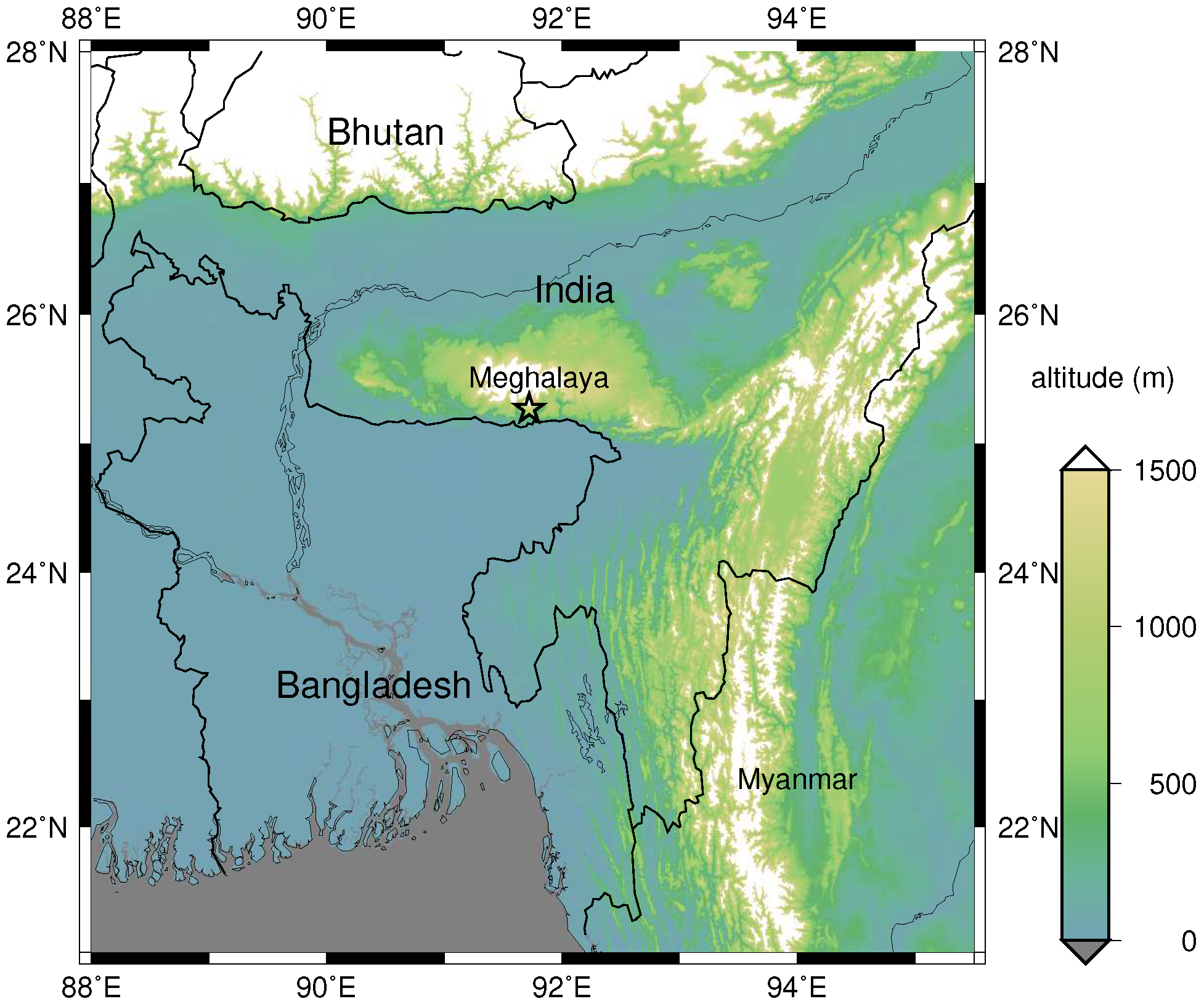
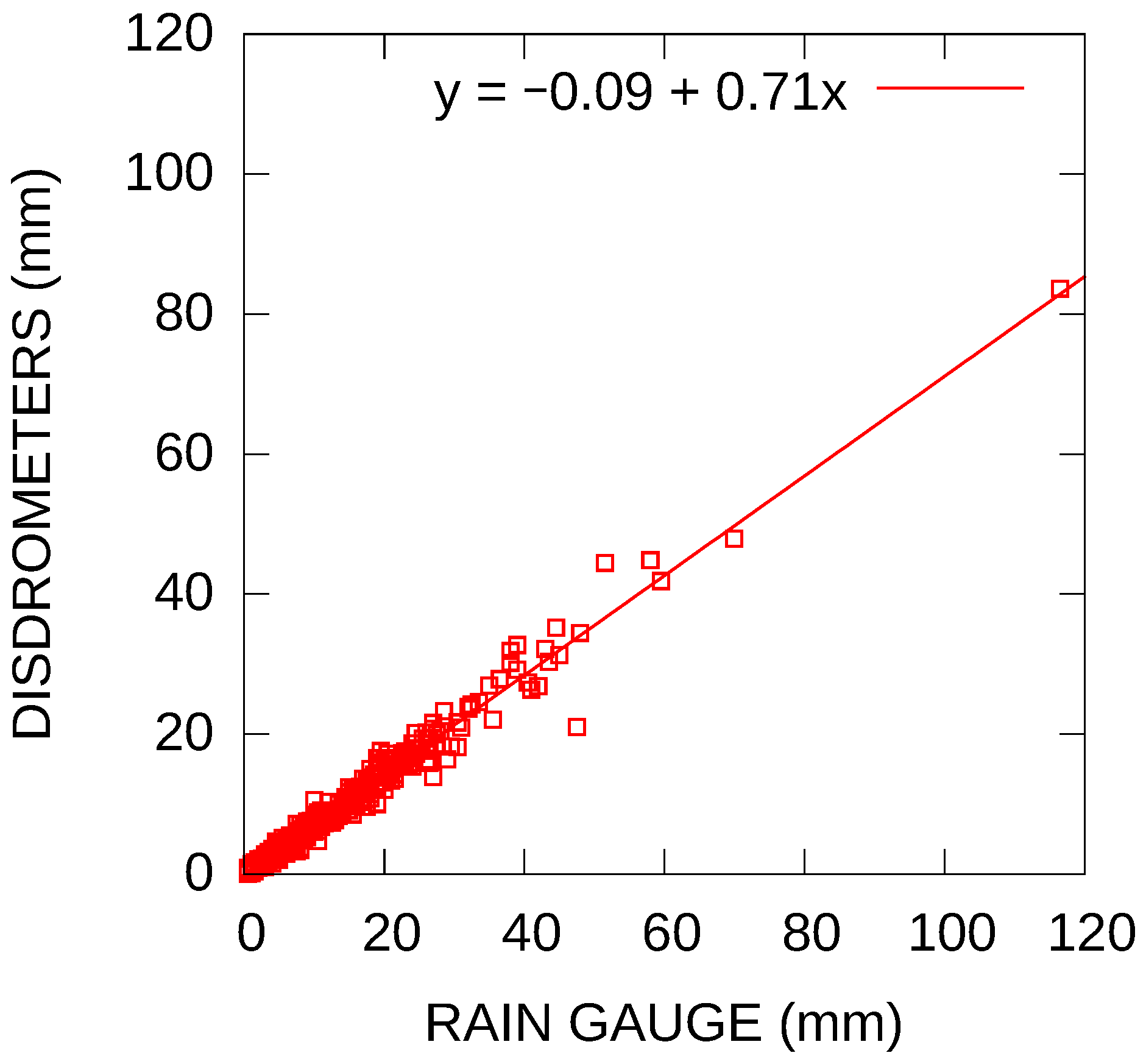

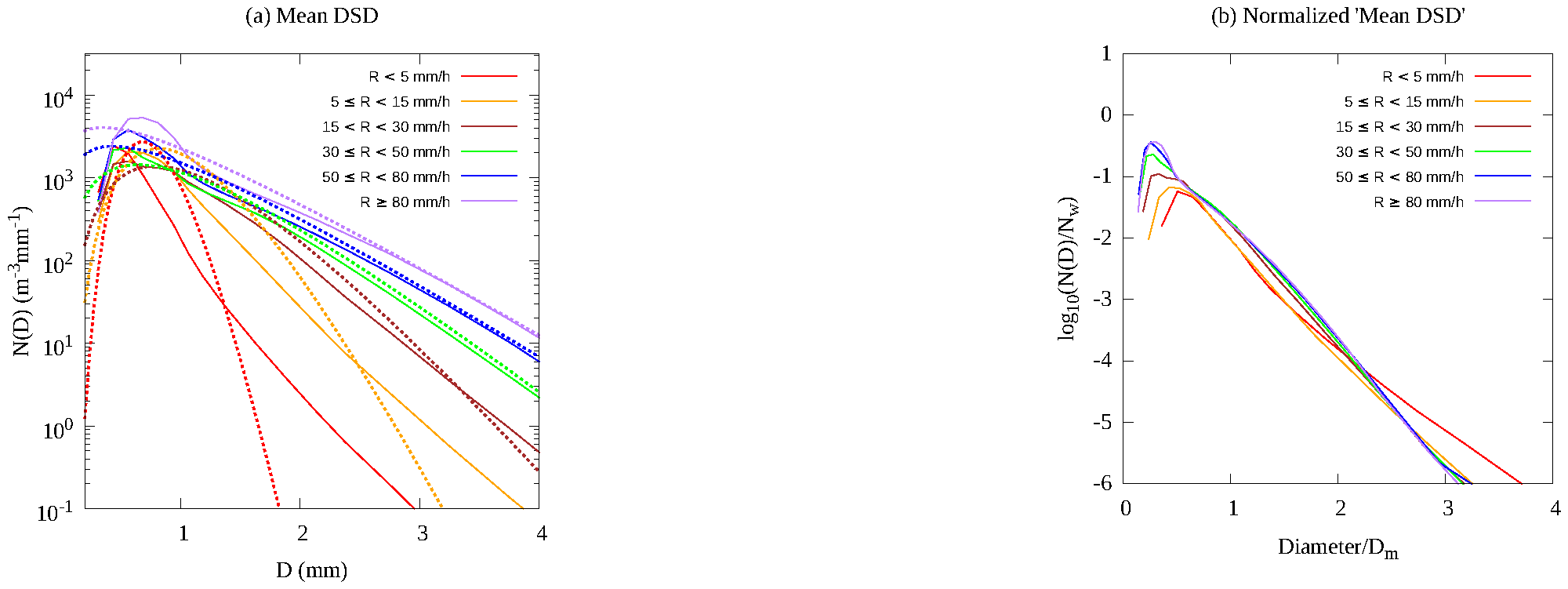
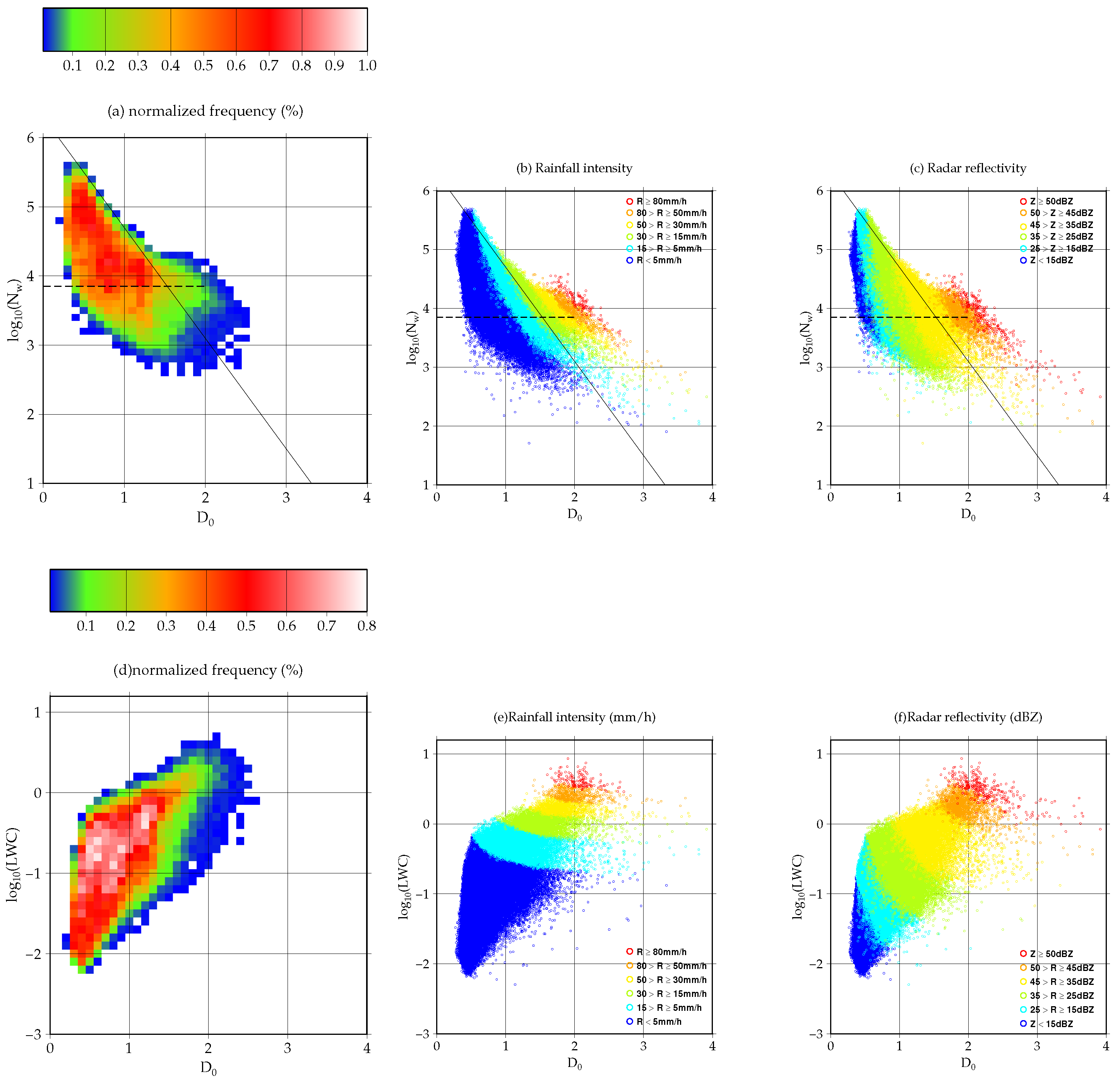

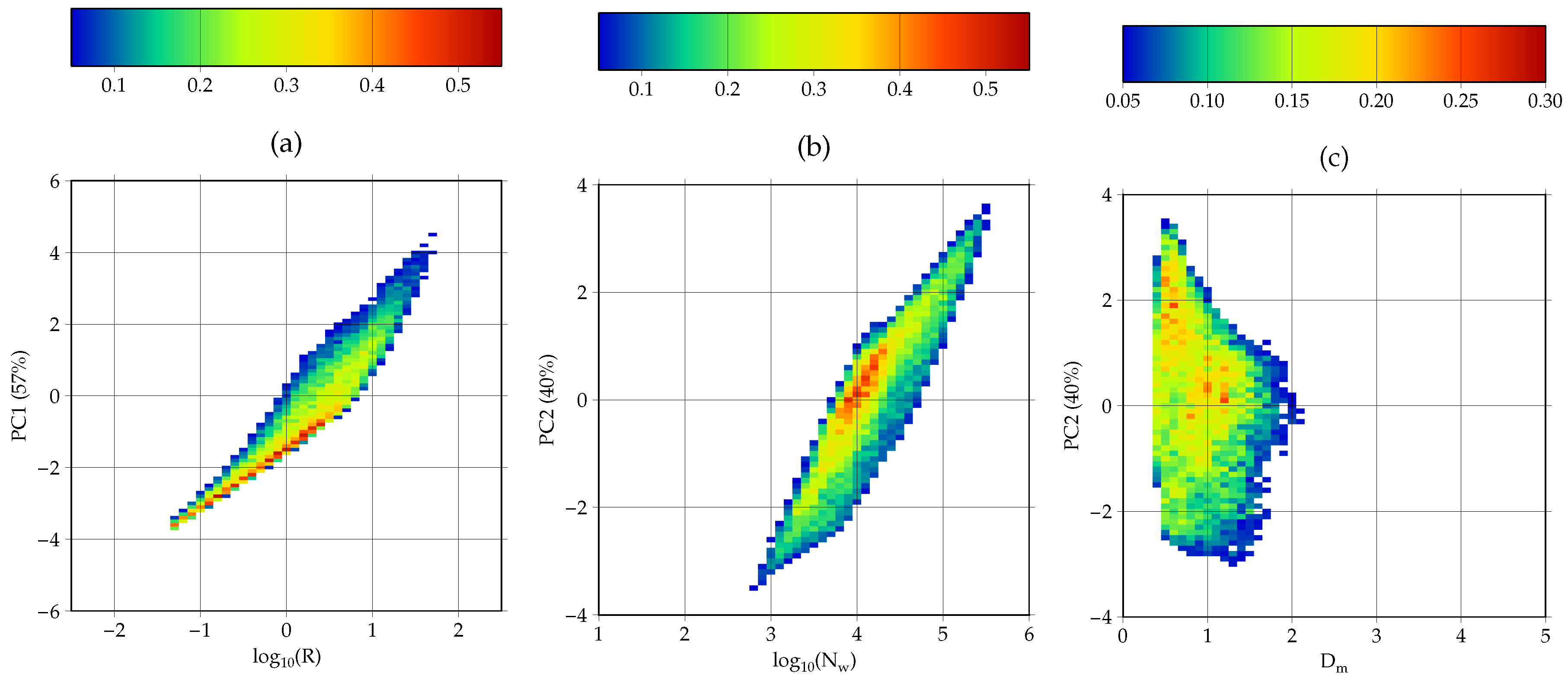

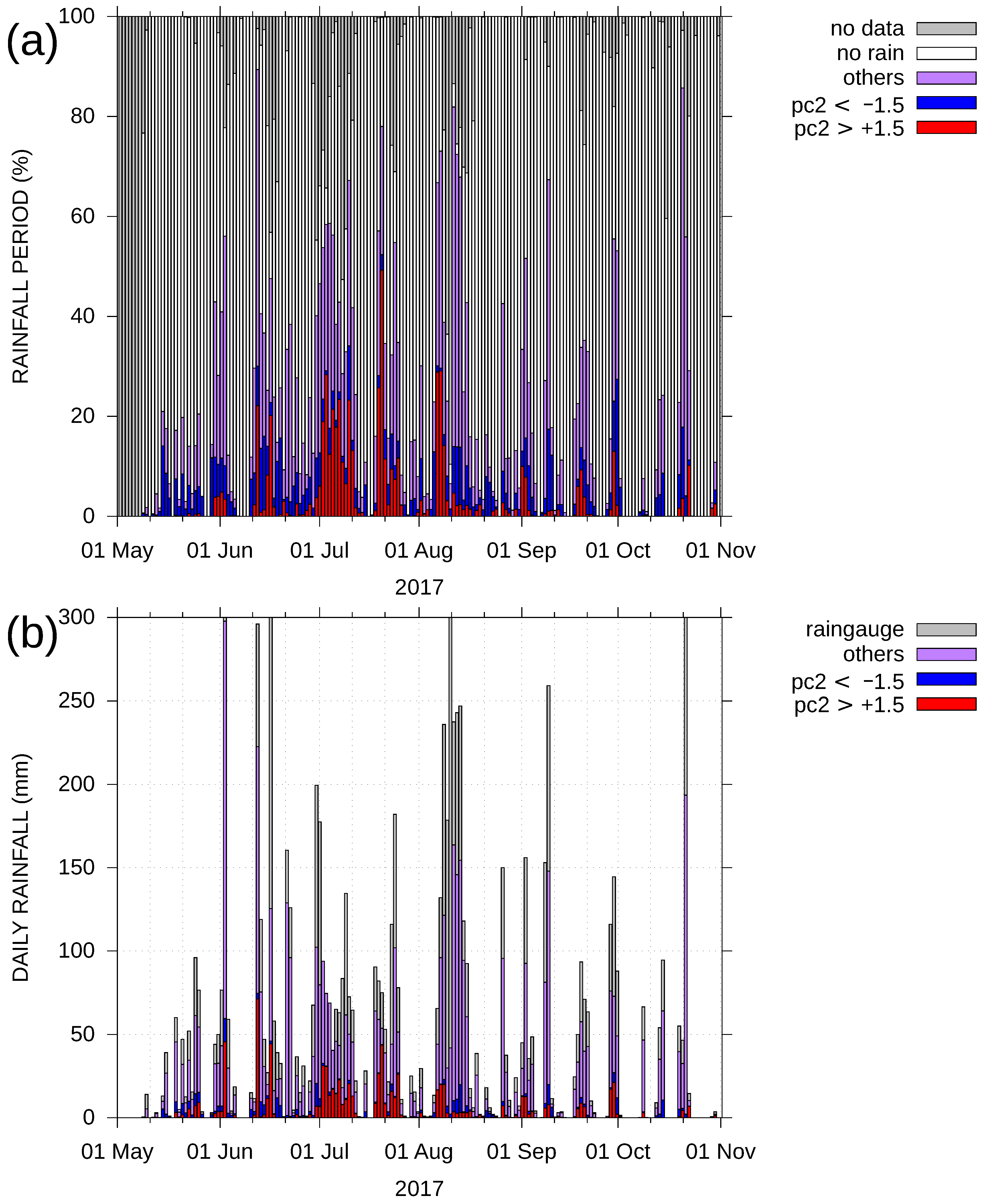
| Category | Num. of 1-min Data | Accum. of Rain | log | Z | log | log | ||
|---|---|---|---|---|---|---|---|---|
| 80 | 139 (0.2%) | 231.513 mm (4.4%) | 2.072 | 4.162 | 0.725 | 51.831 | 3.581 | 0.629 |
| 50 80 | 533 (1.1%) | 542.623 mm (10.2%) | 2.009 | 4.023 | 0.974 | 49.189 | 3.407 | 0.421 |
| 30 50 | 1328 (2.7%) | 838.700 mm (15.8%) | 1.837 | 4.001 | 1.874 | 45.880 | 3.240 | 0.232 |
| 15 30 | 3660 (7.4%) | 1263.122 mm (23.8%) | 1.530 | 4.158 | 3.484 | 41.149 | 3.140 | 0.021 |
| 5 15 | 10,578 (21.3%) | 1540.990 mm (29.0%) | 1.187 | 4.493 | 6.508 | 34.431 | 3.127 | -0.268 |
| 5 | 33,373 (67.3%) | 895.592 mm (16.8%) | 0.770 | 4.631 | 14.759 | 20.662 | 2.958 | -0.873 |
| Month | log | Z | log | log | R | ||
|---|---|---|---|---|---|---|---|
| MAY | 0.889 | 3.653 | 7.912 | 20.734 | 2.304 | −1.298 | 0.752 |
| JUN | 1.060 | 4.225 | 6.114 | 32.077 | 2.988 | −0.414 | 6.926 |
| JUL | 0.630 | 5.018 | 19.630 | 23.799 | 3.365 | −0.509 | 3.320 |
| AUG | 1.107 | 4.161 | 5.578 | 32.626 | 2.967 | −0.409 | 7.044 |
| SEP | 0.855 | 4.295 | 10.068 | 25.558 | 2.876 | −0.737 | 2.766 |
| OCT | 0.894 | 3.957 | 7.427 | 23.989 | 2.595 | −0.979 | 1.539 |
© 2020 by the authors. Licensee MDPI, Basel, Switzerland. This article is an open access article distributed under the terms and conditions of the Creative Commons Attribution (CC BY) license (http://creativecommons.org/licenses/by/4.0/).
Share and Cite
Murata, F.; Terao, T.; Chakravarty, K.; Syiemlieh, H.J.; Cajee, L. Characteristics of Orographic Rain Drop-Size Distribution at Cherrapunji, Northeast India. Atmosphere 2020, 11, 777. https://doi.org/10.3390/atmos11080777
Murata F, Terao T, Chakravarty K, Syiemlieh HJ, Cajee L. Characteristics of Orographic Rain Drop-Size Distribution at Cherrapunji, Northeast India. Atmosphere. 2020; 11(8):777. https://doi.org/10.3390/atmos11080777
Chicago/Turabian StyleMurata, Fumie, Toru Terao, Kaustav Chakravarty, Hiambok Jones Syiemlieh, and Laitpharlang Cajee. 2020. "Characteristics of Orographic Rain Drop-Size Distribution at Cherrapunji, Northeast India" Atmosphere 11, no. 8: 777. https://doi.org/10.3390/atmos11080777
APA StyleMurata, F., Terao, T., Chakravarty, K., Syiemlieh, H. J., & Cajee, L. (2020). Characteristics of Orographic Rain Drop-Size Distribution at Cherrapunji, Northeast India. Atmosphere, 11(8), 777. https://doi.org/10.3390/atmos11080777





